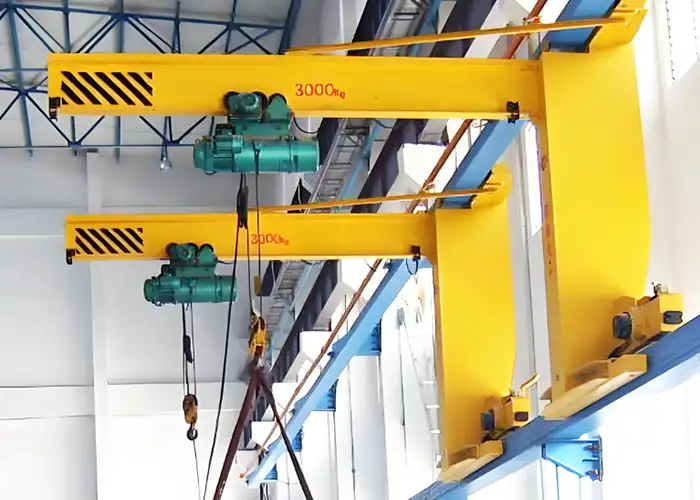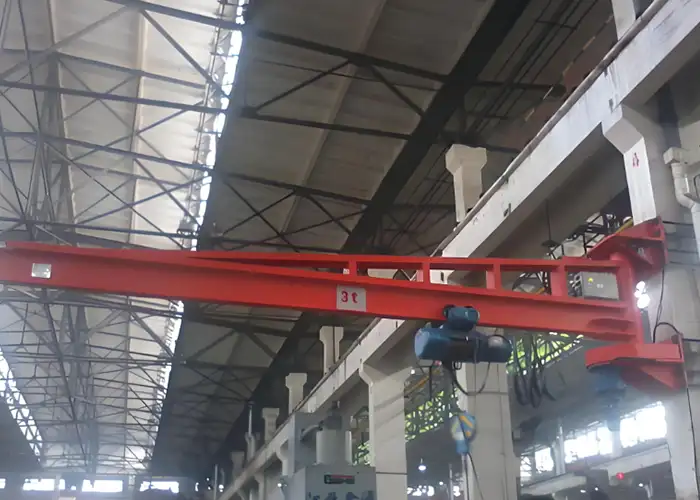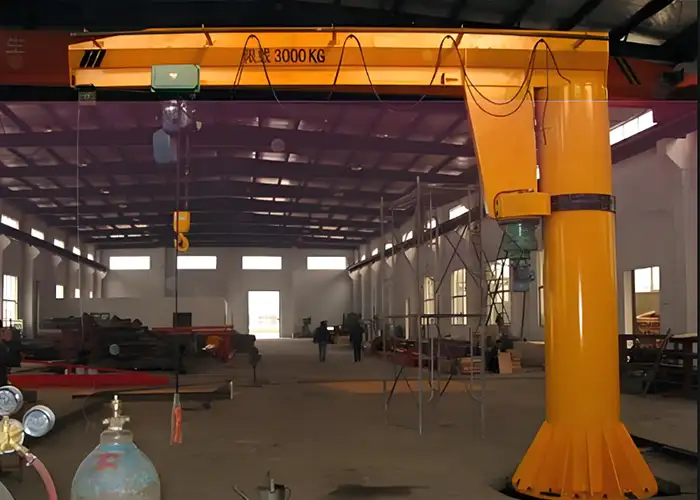3-Ton Jib Cranes: Specifications, Features, and Cost Factors
Compare 3-ton jib cranes by specifications, features, and cost factors to find the best option for your industry needs.
Jib cranes play a crucial role in various industrial settings by providing versatile and efficient lifting solutions. These cranes are especially valuable for tasks involving the handling and moving of heavy materials within a defined area, which enhances workflow and operational efficiency. Their design allows for greater maneuverability and precise control, making them ideal for applications in manufacturing, warehousing, and assembly operations.
The purpose of this comparison is to evaluate 3-ton jib cranes, focusing on their specifications, features, and cost factors. By examining these aspects, we aim to provide a clear understanding of how different models stack up against each other. This comparison will help businesses make informed decisions based on their specific needs and operational requirements.
In this analysis, we will cover:
- Specifications of 3-Ton Jib Cranes: Key technical details such as load capacity, reach, height, and materials used.
- Key Features: Important aspects including rotation, safety features, ease of operation, and maintenance.
- Cost Factors: Considerations related to purchase price, installation, operational costs, and long-term investment.
- Comparing Models and Manufacturers: Insights into different brands, their models, performance, reliability, and support options.
This structured approach will provide a comprehensive overview, aiding in the selection of the most suitable 3-ton jib crane for various industrial applications.
Specifications of 3-Ton Jib Cranes
- Load Capacity The defining feature of a 3-ton jib crane is its maximum load capacity of 3 tons (6,000 pounds). This capacity allows the crane to handle substantial weights, making it suitable for various heavy-duty tasks. Common applications for these cranes include lifting and moving large components in manufacturing facilities, handling bulk materials in warehouses, and assisting in assembly processes. Industries that frequently use 3-ton jib cranes include automotive manufacturing, construction, and general industrial environments.
- Reach and Span The reach and span of a 3-ton jib crane determine how far the crane's hook or lifting mechanism can extend from its base. Standard jib cranes typically offer a reach ranging from 10 to 20 feet, though this can vary depending on the model and manufacturer. Reach and span dimensions are crucial for defining the operational area of the crane and its ability to access different parts of the workspace. Many jib cranes come with customizable options, allowing businesses to adjust the reach to fit specific spatial constraints and operational needs. Customization might include extending the reach or adjusting the crane's mounting configuration to optimize coverage.
- Height and Clearance Height and clearance are important considerations for ensuring that a 3-ton jib crane can operate effectively within its intended environment. Typical height requirements include the distance from the crane’s base to the top of the lifting mechanism, which must accommodate the tallest loads and provide enough clearance for efficient operation. Clearance under the crane is equally important, as it affects how easily materials can be moved and placed. Inadequate height or clearance can limit the crane’s functionality and reduce overall operational efficiency. Ensuring that the crane’s height and clearance meet the specific requirements of the workspace is essential for smooth and safe operations.
- Construction Materials 3-ton jib cranes are commonly constructed from materials such as steel and aluminum. Steel is favored for its strength and durability, making it suitable for heavy-duty applications and high-stress environments. Aluminum, on the other hand, offers a lighter weight and is resistant to corrosion, which can be advantageous in environments with high humidity or exposure to chemicals. The choice of materials impacts the crane’s strength, longevity, and maintenance requirements. Steel cranes are generally more robust but may require additional maintenance to prevent rust and damage. Aluminum cranes, while lighter and more resistant to corrosion, may not support the same heavy loads as steel models. Understanding these material properties helps in selecting a crane that balances strength, durability, and operational efficiency for specific industrial needs.
Key Types of 3-Ton Jib Cranes and Specifications
Wall-Traversing Jib Crane The 3-ton wall-traveling jib crane operates along runways mounted on walls, maximizing the usable work area. It allows extensive lateral material movement without occupying floor space and facilitates vertical lifting and lowering with its lift device. The length of the runways can be tailored to specific work requirements, with no fixed limitations.
Specifications for 3-Ton Wall-Traversing Jib Crane (Model BB):
- Lifting Capacity: 0.5-16t
- Effective Radius: 5-12.5m
- Lifting Height: 6-30m
- Lifting Speed: 0.35-8m/min
- Hoist Travel Speed: 10m/min
- Crane Travel Speed: 20m/min
- Work Duty: A3, A4
Wall-Mounted Jib Crane The 3-ton wall-mounted jib crane makes use of existing building structures for support, eliminating the need for additional floor foundations. This cost-effective crane is ideal for lifting and moving loads while avoiding the expense of new construction.
Specifications for 3-Ton Wall-Mounted Jib Crane (Model BX):
- Lifting Capacity: 0.5-10t
- Effective Radius: 3-8m
- Lifting Height: 6-30m
- Slewing Angle: 0-180°
- Lifting Speed: 0.7-8m/min
- Travel Speed: 10m/min
- Slewing Speed: 0.4-1r/min
- Work Duty: A3, A4
Pillar-Mounted Jib Crane The 3-ton pillar-mounted jib crane is designed for lifting and transporting loads within a workspace without interference from walls or other obstacles. It offers 360-degree rotation upon request, making it ideal for applications requiring extensive hook travel and low headroom.
Specifications for 3-Ton Pillar-Mounted Jib Crane (Model BZ):
- Lifting Capacity: 0.5-20t
- Effective Radius: 3-15m
- Lifting Height: 3-8m
- Slewing Angle: 0-360°
- Lifting Speed: 0.33-8m/min
- Travel Speed: 10m/min
- Slewing Speed: 0.4-1r/min
- Work Duty: A3, A4
All these jib crane types are available from Aimix. Each crane is designed to enhance lifting efficiency and productivity, suitable for various indoor and outdoor applications. Our cranes are adaptable and have been successfully exported worldwide, with high customer satisfaction regarding quality. For more information or to request a quotation, please contact us via email to discuss the best crane solution for your specific needs.
Key Features of 3-Ton Jib Cranes
Rotation and Mobility The rotation and mobility of a 3-ton jib crane significantly impact its versatility and efficiency. Jib cranes typically offer a rotation range that allows the arm to pivot and move the load in a circular area. This range can vary from 180 degrees to a full 360 degrees, depending on the design and model.
Manual vs. Motorized Rotation: Manual rotation provides basic functionality, often through a hand crank or similar mechanism, which can be suitable for lighter or less frequent tasks. Motorized rotation, on the other hand, offers smoother and more controlled movement, making it ideal for high-frequency or precise operations.
Types of Base Mounts: The base mount of a jib crane determines how and where it is installed. Common options include:
- Floor-Mounted: Provides stability and is suitable for fixed locations where the crane will remain in one spot.
- Wall-Mounted: Attached to a wall or column, saving floor space and allowing for use in tighter areas.
- Base Plate Mounted: Installed on a plate or foundation, offering flexibility in placement and stability.
- Overload Protection: This feature prevents the crane from lifting loads beyond its maximum capacity, reducing the risk of mechanical failure and ensuring safe operation.
- Emergency Stop Systems: These systems provide a quick way to halt crane operations in case of an emergency, helping to prevent accidents and injuries.
- Safety Certification Standards: Many jib cranes comply with industry safety standards and certifications, such as those set by OSHA or ANSI. These standards ensure that the crane meets safety requirements and performs reliably under various conditions.
- Manual vs. Electric Controls: Manual controls are typically more straightforward and less expensive but may require more physical effort and time. Electric controls, including powered hoists and motors, offer greater ease of use with less physical strain and can increase productivity through faster and more precise operation.
- Ergonomics and User-Friendly Design: A well-designed jib crane should be ergonomically friendly, with controls and features that are easy to reach and operate. This includes adjustable heights, intuitive control panels, and clear visibility of the load area to enhance user comfort and reduce the risk of operator fatigue.
- Maintenance Requirements: Routine maintenance typically involves checking and lubricating moving parts, inspecting for wear and tear, and ensuring that safety features are functioning correctly. Proper maintenance helps prevent breakdowns and extends the crane’s operational life.
- Expected Lifespan and Durability Factors: The lifespan of a jib crane can vary based on factors such as material quality, frequency of use, and operating conditions. Steel cranes generally offer robust durability but may require more frequent maintenance to address issues like rust. Aluminum cranes provide resistance to corrosion and can be durable in harsh environments but may have different wear characteristics. Understanding these factors helps in planning for long-term use and maintenance.
- Freestanding Jib Cranes: Typically range from $5,000 to $15,000. These cranes are designed for flexibility and can be placed anywhere in a facility, making them a popular choice for many applications.
- Wall-Mounted Jib Cranes: Generally cost between $3,000 and $10,000. They are ideal for maximizing floor space and are often used when existing structures can support the crane's load.
- Articulating Jib Cranes: These are more specialized and can range from $6,000 to $20,000. They offer enhanced mobility and are suited for more complex lifting tasks.
- Material Quality: Cranes constructed from high-grade steel or those with specialized coatings for corrosion resistance tend to be more expensive but offer increased durability.
- Additional Features: Options such as motorized rotation, electric hoists, or advanced safety features can significantly increase the initial cost.
- Brand and Manufacturer: Established brands with a reputation for quality and reliability may command higher prices due to their superior design, materials, and customer support.
- Typical Installation Expenses: Installation costs for a 3-ton jib crane typically range from $500 to $3,000. Factors such as crane type, mounting style (floor, wall, or ceiling), and the need for specialized equipment or expertise can influence the overall cost.
- Additional Costs for Site Preparation: Some sites may require additional preparation, such as reinforcing existing structures, installing new foundations, or modifying the workspace layout to accommodate the crane. These preparations can add significantly to the installation cost. For example, a freestanding jib crane may require a concrete foundation, while a wall-mounted model might necessitate structural reinforcement of the mounting surface.
- Energy Consumption: Motorized jib cranes require electricity to operate the hoist and rotation mechanisms. The energy costs will depend on the crane's usage frequency, duration, and power requirements. Electric models may have varying energy efficiency levels, which should be considered when calculating long-term costs.
- Routine Maintenance and Repair: Regular maintenance is crucial to ensure the crane operates safely and efficiently. Maintenance tasks might include inspecting and lubricating moving parts, checking for wear and tear, and replacing any faulty components. The cost of routine maintenance and minor repairs can range from a few hundred to several thousand dollars annually, depending on usage and environmental conditions.
- Total Cost of Ownership: The total cost of ownership includes all expenses associated with the crane over its lifetime, such as initial purchase and installation, energy consumption, routine maintenance, repairs, and any necessary upgrades. Calculating this total cost helps businesses understand the full financial impact of their investment and plan for future expenses.
- Return on Investment (ROI) Analysis: A well-chosen jib crane can significantly enhance productivity, improve safety, and reduce labor costs, resulting in a favorable ROI. To evaluate ROI, businesses should consider the crane's ability to meet their operational needs effectively, the cost savings it provides over manual lifting methods, and the potential increase in operational efficiency and workflow optimization. By comparing these benefits against the total cost of ownership, companies can determine the overall value and payback period for their investment in a 3-ton jib crane.
- Overview of Top Brands in the Market: Leading brands such as Gorbel, Spanco, and Demag have established themselves as industry leaders by consistently providing high-quality jib cranes. These manufacturers are known for their commitment to safety, durability, and user-friendly design, making them popular choices among industrial buyers.
- Notable Models and Their Distinguishing Features: Within each brand, specific models stand out due to their unique features and capabilities. For instance, Gorbel's wall-mounted articulating jib crane offers enhanced flexibility and reach in tight spaces, while Spanco’s freestanding models are celebrated for their robust construction and ease of installation. Demag’s motorized jib cranes provide smooth, precise movements, which are ideal for applications requiring frequent adjustments and load positioning. Each model has distinct advantages tailored to different operational needs and environments, allowing businesses to select a crane that best suits their specific requirements.
- User Reviews and Performance Metrics: User reviews offer valuable insights into the real-world performance of jib cranes. Customers often highlight aspects such as ease of installation, reliability, and after-sales support, providing a comprehensive view of a crane's strengths and potential drawbacks. Performance metrics, such as lifting speed, rotation smoothness, and load handling efficiency, are essential for evaluating how well a crane meets its intended purpose. For example, a crane that operates smoothly and maintains a high degree of precision under load is likely to be more reliable in high-stress environments.
- Case Studies of Different Models in Operation: Case studies provide concrete examples of how various models perform in specific industries and applications. For instance, a case study might explore how a particular model of a jib crane improved workflow efficiency in a manufacturing plant or contributed to safer material handling in a warehouse setting. By examining these real-world applications, potential buyers can better understand which crane models are best suited to their operational needs and challenges.
- Typical Warranty Terms: Most leading manufacturers offer warranties ranging from one to five years, covering parts and labor for defects in materials and workmanship. Some brands may also provide extended warranties or additional coverage for specific components, such as the hoist or motor, which are subject to wear and tear. Understanding the warranty terms helps buyers anticipate potential future costs and ensures they are covered in case of unexpected issues.
- Manufacturer Support and Service Options: Manufacturer support can include technical assistance, training, and readily available replacement parts. Brands with a strong support network can assist with installation, provide routine maintenance services, and offer rapid response times for repairs. Additionally, some manufacturers provide training programs for operators and maintenance staff, enhancing safety and operational efficiency. Choosing a manufacturer with comprehensive support options ensures that businesses can rely on prompt assistance and maintain optimal crane performance over its lifespan.
By carefully comparing different models and manufacturers, businesses can select a 3-ton jib crane that meets their specific needs, ensuring long-term reliability, safety, and cost-effectiveness.
Conclusion: Get Your Custom 3 Ton Jib Crane Design
Choosing the right 3-ton jib crane involves evaluating a variety of factors, including specifications, features, costs, and manufacturer options. A thorough understanding of these elements ensures that businesses make informed decisions that align with their operational needs and budget.
- Summary of Key Points: Throughout this comparison, we have explored the critical specifications of 3-ton jib cranes, such as load capacity, reach, span, height, and construction materials, which directly affect the crane’s performance in various industrial settings. Key features like rotation, mobility, safety systems, ease of operation, and maintenance requirements play a significant role in determining a crane's suitability for specific tasks and environments. Additionally, understanding the full range of costs—from the initial purchase price and installation expenses to long-term operational costs—enables buyers to gauge the total cost of ownership accurately.
- Recommendations Based on Specific Needs and Applications: For businesses prioritizing flexibility and ease of installation, freestanding models with manual rotation are often the most cost-effective choice. Conversely, operations requiring precise positioning and frequent adjustments may benefit from motorized models with advanced control systems. Industries where safety is a top priority, such as manufacturing or material handling, should focus on cranes with comprehensive safety features, including overload protection and emergency stop systems. Additionally, companies operating in corrosive or extreme environments should consider cranes constructed from high-quality materials with specialized coatings to ensure long-term durability.
- Final Thoughts on Choosing the Right 3-Ton Jib Crane: Ultimately, the best 3-ton jib crane for your business will depend on a balanced consideration of specifications, features, costs, and manufacturer support. It's crucial to assess your specific operational needs, workspace constraints, and budget to select a crane that offers the best performance, reliability, and value. By investing in a high-quality jib crane tailored to your unique requirements, you can enhance productivity, improve safety, and achieve a favorable return on investment over the crane’s operational lifespan.




